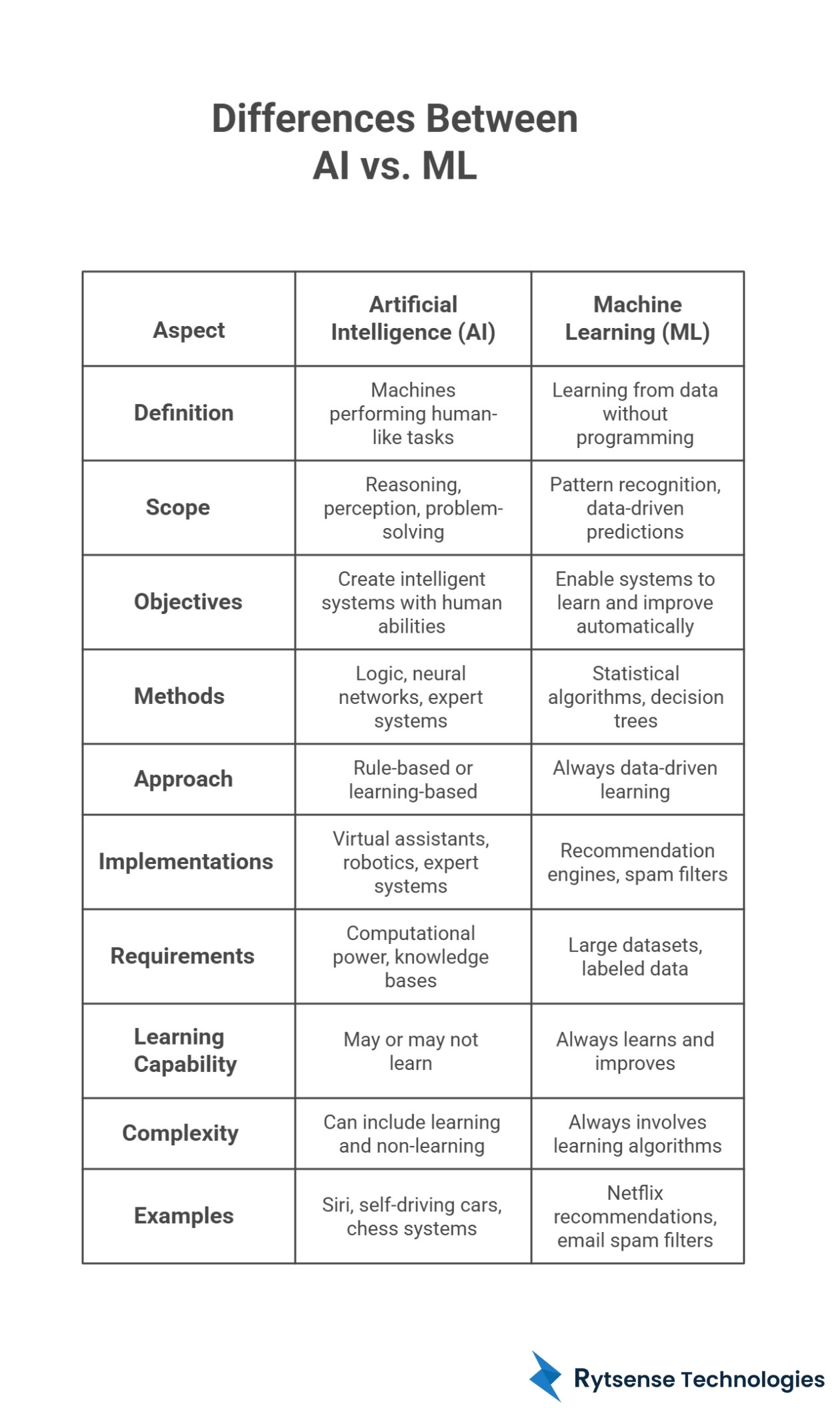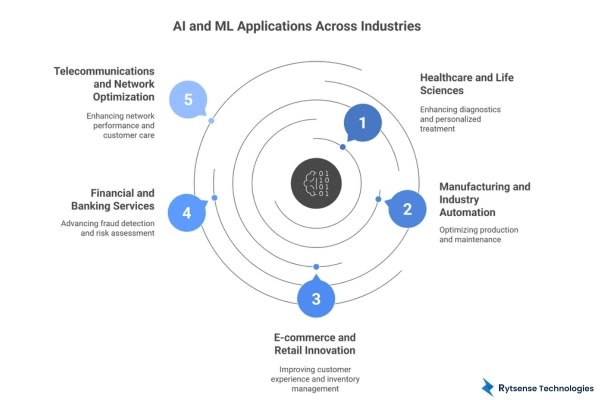-
Key Takeaways
- Machine learning is a subset of AI, meaning all ML is AI, but not all AI uses ML, with AI being the broader goal and ML providing the learning mechanism.
- Combined AI/ML systems deliver broader data utilization, accelerated decision-making from days to milliseconds, enhanced efficiency, and integrated analytics capabilities across organizations.
- AI/ML applications span healthcare diagnostics, manufacturing predictive maintenance, e-commerce personalization, financial fraud detection, and telecommunications network optimization, delivering measurable industry-wide value.
- AI implementations require computational power and use various techniques, from rule-based to neural networks, while ML specifically needs large, high-quality datasets and continuous model validation.
- Organizations should start with pilot projects, assess data infrastructure, build cross-functional teams, and partner with vendors like Rytsense Technologies for successful AI/ML implementation.
Artificial Intelligence (AI) vs. Machine Learning (ML)
What Is Artificial Intelligence (AI)?
What Is Machine Learning (ML)?
How Are AI and ML Connected?
In the past, AI systems operated from rule-based programming, where the behavior was obtained from static commands. In contrast, next generation AI systems use machine learning, which allow for data-driven algorithms that can learn, adapt, and self-improve. Nowadays, numerous AI software applications are based on machine learning so that systems may continually progress and ultimately make more intelligent decisions.
Major Differences Between AI and ML
AI and ML are vastly different areas of study and application in terms of their scope, goals, techniques, and methods of implementation. AI is the more general goal of making intelligent systems that imitate human behavior, while ML is defined as data-driven learning with pattern recognition (machine learning). AI/ML requirements, complexity, and applications will differ greatly by industry and use case.

Objectives
Conversely, Machine Learning (ML) is a domain of AI that focuses on designing systems that learn from data and enhance their performance over time. Rather than using a predetermined set of rules, ML algorithms utilize input data to analyze previous information, recognize patterns, and generate predictions or decisions based on those earlier examples without requiring explicit instructions for each new situation.
Methods
Machine Learning (ML), a key subset of AI, uses statistical algorithms and training datasets to learn from data and refine prediction accuracy over time. Typical machine learning techniques include decision trees, random forests, support vector machines (SVMs), and neural networks. By utilizing ML in an AI system, organizations can combine techniques, resulting in intelligent AI/ML solutions that generate optimal data-based outcomes.
Also Read:
AI ML Use CasesImplementations
Machine Learning (ML), a primary branch of AI, powers applications including but not limited to spam filtering, product recommendation engines, credit scoring, fraud detection, and predictive maintenance systems. These data-based approaches allow organizations to automate processes, improve accuracy, and can even make more intelligent decisions based on real-time data.
Needs
Similarly, Machine Learning (ML) implementations demand comparable infrastructure but place greater emphasis on high-quality, labelled datasets for model training. ML projects even involve extensive data preprocessing, feature engineering, and ongoing validation to ensure model accuracy and reliability across different use cases.
Harness the power of AI and Machine Learning to transform your business operations, boost efficiency, and make smarter decisions. Discover how custom AI/ML solutions can solve your unique challenges and drive growth.
Benefits of Using AI and ML Together
Broader Data Utilization
Decision-Making
Read Also:
AI Development CostEnhanced Efficiency and Accuracy
Integrated Analytics Abilities
Applications of AI and ML Across Industries

Healthcare and Life Sciences
Manufacturing and Industry Automation
Systems based on computer vision are inspecting products for defects or anomalies that are not visible to the human eye. Also, AI-enabled robotic systems have contributed to more flexible manufacturing, allowing production lines to switch between different products without reprogramming to improve efficiency with production flexibility.
E-commerce and Retail Innovation
Financial and Banking Services
Telecommunications and Network Optimization
Take the next step toward smarter business decisions. Implement AI and ML solutions that adapt, learn, and deliver measurable results.
How Organizations Can Get Started with AI and ML
Where internal knowledge is not enough, organizations should discuss engaging vendors experienced in custom AI/ML solution development. They should also consider implementing governance processes encompassing data privacy, security, ethics, and compliance. To accommodate growing workloads in the domains of AI/ML, organizations may need to invest in cloud platforms and/or advanced computing infrastructure that can scale with the expectation of increased demand. Finally, organizations should consider implementing structured learning programs to keep teams informed with the latest developments in AI and ML, and to continually upskill their capabilities.
How Rytsense Technologies Can Support Your AI and Machine Learning Requirements
In addition, we offer consulting services to help organizations identify high-value use cases and also develop actionable implementation roadmaps. We even support the sustainment of AI/ML systems, ensuring ongoing value as business requirements evolve. Finally, we implement modern, scalable solutions capable of growing with your organization while handling increasing data volumes and complexity.
Meet the Author

Karthikeyan
Connect on LinkedInCo-Founder, Rytsense Technologies
Karthik is the Co-Founder of Rytsense Technologies, where he leads cutting-edge projects at the intersection of Data Science and Generative AI. With nearly a decade of hands-on experience in data-driven innovation, he has helped businesses unlock value from complex data through advanced analytics, machine learning, and AI-powered solutions. Currently, his focus is on building next-generation Generative AI applications that are reshaping the way enterprises operate and scale. When not architecting AI systems, Karthik explores the evolving future of technology, where creativity meets intelligence.